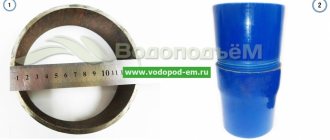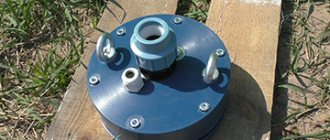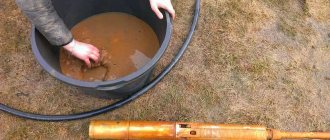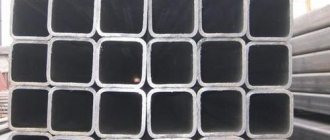Quality of the material: (What is your assessment of the article?)
Plastic casing pipes have gained wild popularity and are offered by any drilling company; we are no exception and also lower them into wells. Often plastic is placed inside a steel casing, but some may line the well with only plastic pipes. Now we will leave a detailed review about plastic pipes, in which we will find out which well is better made of plastic or metal, share our experience, dispel some myths, and talk about the main differences between pipes. We’ll also tell you why they started using HDPE pipes in the well and whether it’s a scam.
First, let's decide what is better for a HDPE or PVC well. As PVC is known to be poisonous and release vinyl chloride, some countries have long abandoned its use. The HDPE material is neutral and is widely used not only for water supply to a private home, but also in urban networks.
We’ve sorted this out, then we’ll look at the main sizes of plastic pipes for wells and find out which ones are better.
Casing pipe 125 mm
The main diameter of the HDPE pipe for wells, which, as a rule, is installed inside a 159 mm or 152 mm steel pipe, but sometimes they are used without a metal casing. In the Moscow region, a 125 mm HDPE pipe with a wall thickness of 7.1 mm is very popular. If this 125 mm food blue pipe is installed without steel, then use the version with a 9 mm wall. Here we have described everything about the design of metal 159 + plastic 125 mm and why it is needed. At the ends of the 125th pipe, threads are cut, through which one pipe is connected to another.
Pros and cons of casing 125 plastic pipe:
- Cheap. Allows you to significantly reduce the cost of a well compared to a metal pipe.
- Any pump for a well 125 mm in diameter will do. The internal diameter of this pipe is 111 mm, which means any inexpensive 4-inch well pump will fit into it without problems.
- It is impossible to case wells without steel to great depths.
Performance characteristics
The pipes are sufficiently durable and have a favorable price. In addition, they are convenient to assemble: they are lightweight, and the installation technology is simple and accessible to non-specialists. The threaded connections are so strong that they allow the polymer pipeline to be pulled out of the drilling rig if necessary.
- Bends are produced with and without socket.
- The range of working sections used for casing varies from 80 to 225 mm.
- The maximum internal pressure for uPVC bends is 25 MPa.
- They can be installed at a depth of up to 100 meters, and reinforced versions (with thick walls) - up to 300 meters.
The products have a smooth surface, providing high throughput capacity, resistance to overgrowth and bacterial growth.
Casing pipe 117 mm
Due to the fact that they began to drill with a thin 133 mm pipe, the wall thickness of which is 4.5 mm (or less), and the internal diameter is 124 mm, it became possible to install a 117 mm HDPE casing pipe in it, where it works as a production string. You can find out why you need a 133 mm well + 117 mm HDPE here. This is a complete analogue of the 125 mm pipe described above, but slightly smaller. Its internal diameter is 102 mm (in practice 100-101 mm), which makes it possible to put a 4-inch pump back to back and have problems trying to get it out of there when it breaks. That is why in HDPE 117 mm it is better to install a pump with a diameter of 3 inches or 3.5 inches.
Advantages and disadvantages of 117 mm HDPE pipes:
- Extremely cheap.
- You can install a 4-inch pump.
- It is almost impossible to get a 4-inch pump out of a well. On the outside, this pipe is beautiful and round, but on the inside there are sagging and unevenness. Plus, during operation, the pump can pull up micro-particles of sludge that get between the pump and the pipe. The places where the pipes connect to each other are also not perfectly straight, and even very small protrusions will become a problem if the pump is placed so tightly. Remember: most drillers just want to get done and leave, but you will have to get that pump out when it breaks. The price of well repair can be a very unpleasant surprise.
Technology
There is also a technological way to overcome this obstacle, and not even in one version.
Thus, all the difficulties that the work manufacturer faces in terms of using uPVC pipes as casing, as an alternative to steel, are completely surmountable.
Well owners often have concerns associated with the name of the uPVC pipe material - polyvinyl CHLORIDE! This means chlorine, which means poison. It is not known what it is based on, it is not clear who started it, but there is concern. You don’t have to dwell on this for a long time; one quote will suffice:
The use of PVC in modern medicine has become almost irreplaceable. It is used to make: medical sterile reservoirs for blood and organs, gloves and masks, catheters, tubes for various purposes, medical devices, surgical splints, packaging for medicines.
Pipe for well 110 mm
This size of plastic pipes is used in seamless 133 mm pipes or reinforced suture ones. Due to the greater wall thickness, the internal diameter of these 133 mm pipes is 123 mm and, due to technical features, it is impossible to drill into them for plastic 117 mm HDPE. Thus, we came to a pipe with an even smaller diameter - 110 mm. The wall thickness of this pipe is 6.3 mm, but due to the small diameter, this is compensated by increased rigidity.
Advantages and disadvantages of 110 mm HDPE casing pipe:
- Cheap.
- The internal diameter of a 110 mm plastic pipe for a well is about 97 mm, which means you will have to install an expensive 3-inch pump, like Grundfos SQ. But if the well is shallow, then you can get by with more affordable Speroni or Chinese pumps.
Well without plastic pipe
It is possible to drill an artesian well without using plastic if there are pressure horizons. For example, if, after drilling a well, water rises into steel pipes, the pump will also stand in a steel casing pipe. But even in this case, it is advisable to plant limestone because it is a unique rock: it can become limp and begin to collapse the trunk... This is not such a big nuisance, but we want a problem-free design.
In places where there is limestone with layers of clay, it is always necessary to plant limestone, because the clay will tint the water and then completely plug the well. In such cases, the area with clay is covered with a solid pipe, and perforation is made in the area of the water carriers.
In general, there can be many designs for a water intake well, and they all depend on the geology of the area; in some places it is needed and in others it is not. So you can't choose to do with or without plastic. Plastic is not a luxury, HDPE pipe is a necessity. If in your case you need to install HDPE, but you refuse, then you will have to omit a more expensive steel pipe.
- Some drilling companies underestimate the price of a meter of drilling, citing the cost without HDPE pipes. You order a well, but during the work it turns out that you cannot do without a plastic casing pipe and you need to pay extra. You either pay extra and are left without the saved 10,000 rubles, or the drillers take money for exploratory drilling and leave, and you are left without money and without a well. Self-respecting companies warn in advance about the possible complexity of geology and the need to use double casing. Here we wrote more about possible deceptions on the part of drillers.
Well casing with plastic pipes
So, the well is drilled and lined with a steel pipe to the limestone, the water sits in the limestone and does not rise into the steel pipes. You cannot lower a deep-well pump into bare limestone (because it will get stuck), so it is first lined with a HDPE pipe and then a pump is placed in this pipe. Previously, metal pipes were used for casing limestone, but they are expensive, today competition has gained alarming proportions and, in pursuit of the best price, everyone has switched to plastic pipes.
When casing limestone, it is customary to place the plastic pipe several meters above the water so that it does not float up.
It is common among people to place a plastic pipe under the top of the well. This doesn’t make any sense, it’s enough to put the pipe 3-5 meters above the water and it won’t float up, the rest is a waste of money.
There is a common myth that if you put a plastic pipe under the top, this provides additional protection from groundwater in the event of through corrosion of the steel pipe. We have to disappoint you: this will not work in most cases. If a steel pipe rusts, water will enter the interpipe, from there into the limestone, and then into your house. If the steel rusts very badly, the plastic will be compressed by the clay.
But sometimes they implement a well design in which the plastic pipe is not lowered to the bottom, but a kind of pocket is made in the limestone, where the plastic is covered with clay. This will protect the well from high water even in the event of through corrosion of the steel. Some drilling organizations offer to put a packer in the well, which looks like a winding on a plastic pipe; it is designed to close the space between the plastic and steel and ensure tightness. But while they are lowering the coiled pipe into the well, this coil will become loose, break, and will be of no use. But the main thing is that no one will ever understand whether the packer has failed or not; the water will still be clean and transparent. There are more complex options for packers, but this means additional money, additional time to install them, and now all companies are following the path of extreme cost reduction and no one will do this for free.
And now the most popular: many drilling organizations say that by installing a plastic pipe, you will only drink water from it. They just throw this pipe into the well and it hangs there. There is water in it, but there is also water between the plastic and steel pipes. You’re not supposed to talk about this, you won’t know it anyway. This is how most drillers work without proper experience. Naturally, if the steel rusts, then you will have water in your tap.
How to make a well only from a plastic pipe
Some companies practice casing the well with plastic pipes without a steel column, they say, plastic is eternal, does not corrode and is environmentally friendly. Let's find out how justified it is to use only plastic in a well.
So, the strength of plastic is lower than steel, so you need to take a pipe with a wall of at least 9 mm. When using a standard 7.1 mm wall, you will experience collapse of the HDPE casing pipe in the well. This is experience-tested information.
It’s especially unpleasant if such a well is made by swindlers. Usually the scheme is this: they make a well, take the money and leave, then the pipe collapses, and it is no longer possible to reach them by phone. We periodically encounter such cases. Here is one of them:
Next, there are difficulties with how to line a well with a plastic pipe. For example, a steel pipe can be rubbed into limestone and thereby isolate the annulus; the steel can be twisted, knocked and everything will be fine with it. This won't work with plastic. The plastic casing pipe simply sits on the limestone and then whatever happens. The surface of the limestone is not perfectly smooth and there will be gaps between the limestone and the pipe. Even if you are lucky and everything works fine, there is no guarantee that, over time, the clay plug will not be washed away under the casing shoe and dirty water will not flow.
The second point in casing: plastic floats in water, and the well is cased when it is filled with drilling fluid, the density of which is even higher than water. Instead of standing more tightly on the limestone, the plastic pipe constantly strives outward with enormous force. Therefore, they try to press it down with a weight and wait until the pipe is covered with clay.
If you need to settle down and continue drilling in a plastic pipe, then you need to try very hard not to break this pipe. Sometimes a boulder can get caught behind the plastic, which will press the HDPE pipe inside and, when drilling, a hole will be rubbed out there. As you may have noticed, the technology for casing with HDPE without steel is somewhat more complicated than with a conventional metal pipe, and mostly beginners drill without steel.
Drilling a well with plastic casing pipes is promoted solely for the purpose of saving money, because the price of HDPE pipes is lower than steel ones.
???????? ??? ??????:
???? ?? ?? ???? ???? ?????, ??????????? ???, ?? ??????? ?????????????? ??????
???????? ?????
?????? :
?????????? ?????????
??????????????? ????: — ???. ?????! ?? ???????????? ???????? ??????? ????? ?? «?? ???????? ?????» ? ???? ??????
????????? ?????? ? ???????? ???? ???? ??????????? — +7
Comparison of caissons
Well cleaning with pump
Selection of pumps for wells
Which well is better made of plastic or metal?
At the end, we will summarize, especially for those who are too lazy to read all the material, we will immediately resolve the question of which casing pipe is better than HDPE or steel. Plastic is good and allows you to reduce the cost of drilling, it works great, but if protected by an iron pipe. A steel pipe is also good, but it is installed before the limestone, and the limestone itself must be lined with plastic. In our area (in the south of the Moscow region) it is impossible to leave limestone without casing. Therefore, the ideal combination is iron and plastic. If you don’t trust HDPE, you can overpay and make metal and metal.
Connection methods
Products with threads are connected very simply. First, they drill a hole that is larger in diameter than the material. The depth is about 2-3 meters. Then they change the drill to a smaller one, but also larger than the material. Drilling continues until the aquifer itself.
After this, the necessary material is inserted into the well and drilling continues. As the casing deepens, another one is screwed onto it from above. To achieve a tighter connection, rubber O-rings are used.











